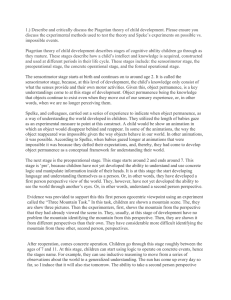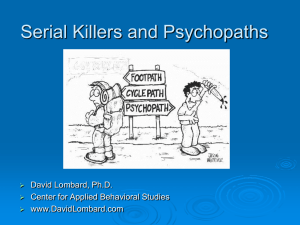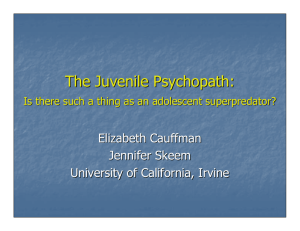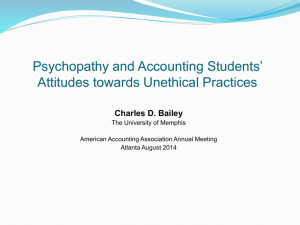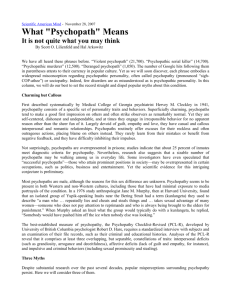Document
advertisement
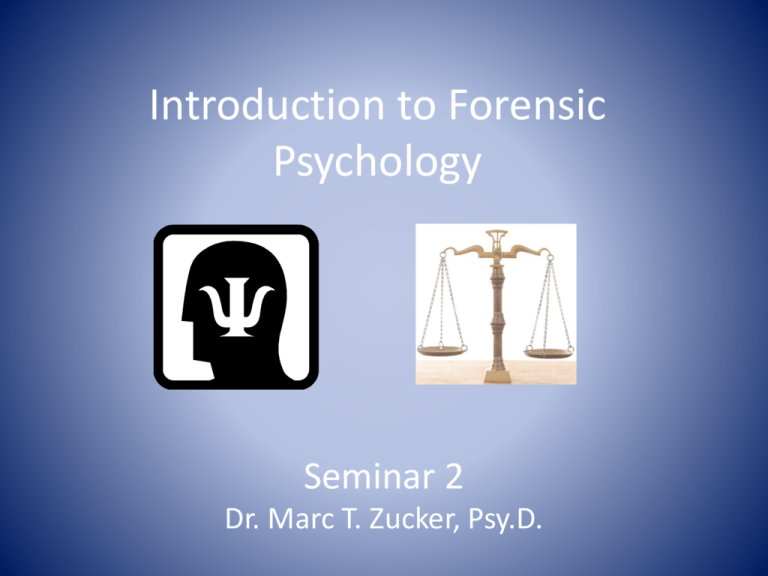
Introduction to Forensic Psychology Seminar 2 Dr. Marc T. Zucker, Psy.D. Welcome • Just a reminder, your midterm essays and midterm project are both due at the end of unit 5! • By now you should have looked over the requirements for both of these assignments and begun to think about them. Unit 2 Graded Assignments • • • • Readings: Chapter 3 of textbook Discussion Forum Seminar Project: 2-3 pages, APA formatted, related to theories of crime…due by the end of the day on Tuesday, April 5. Seminar 2 • Are there any questions regarding current unit (2) or the Chapter for this unit (Chapter 3)? Seminar Topic • Psychopathy and Criminal Behavior • Serial killers such as Ted Bundy, Jeffrey Dahmer, and others have perplexed society for years with their seemingly inexplicable behavior. Chapter 3 uses psychopathy as a possible explanation for criminal behavior. Using this theory, as well as the others mentioned in the text, we will discuss why these men, and others, commit the heinous crimes they do. Psychopathy Psychopathy is NOT a diagnosis in the DSM-IV (Diagnostic and Statistical Manual- Fourth edition)- The reference manual for acceptable diagnosis within the psychological and medical community. Psychopathy closely resembles Antisocial Personality Disorder an Axis II diagnosis in the DSM-IV. DSM-IV Diagnosis of APD • • A. There is a pervasive pattern of disregard for and violation of the rights of others occurring since age 15 years, as indicated by three (or more) of the following: failure to conform to social norms with respect to lawful behaviors as indicated by repeatedly performing acts that are grounds for arrest • deceitfulness, as indicated by repeated lying, use of aliases, or conning others for personal profit or pleasure • impulsivity or failure to plan ahead • irritability and aggressiveness, as indicated by repeated physical fights or assaults • reckless disregard for safety of self or others • consistent irresponsibility, as indicated by repeated failure to sustain consistent work behavior or honor financial obligations • lack of remorse, as indicated by being indifferent to or rationalizing having hurt, mistreated, or stolen from another. • • • B. The individual is at least age 18 years. C. There is evidence of conduct disorder with onset before age 15 years. D. The occurrence of antisocial behavior is not exclusively during the course of schizophrenia or a manic episode. American Psychiatric Association. (1994). Diagnostic and statistical manual of mental disorders (4th ed.). Washington, DC: How to assess • Clinical Interview • Historical information • Prior diagnosis • Collateral information • • • • Family Friends School teachers/others School/legal records • Objective psychological testing • Hare Psychopathy Checklist • MMPI-2 (Minnesota Multiphasic Personality Inventory) Possible explanations for serial murder • Executive Functioning…… Frontal Lobe impairments Tumor Stroke Dead Cells Neuropathological deficits and activity (EEG, MRI) Poor childhood Possible explanations for serial murder (cont.) • Stimulation-Seeking theory…..(pg 79) • Eysenck and lack of development of adequate levels of conscience. • Dysfunctional family » Improper fostering or nurturing of relationships » Inadequate reward and punishment system » Lack of stability Problems with the Psychopathy theory • It provides good explanations for only a small percentage of offenders. • Majority of offenders are NOT psychopathic • According the your course text only ¼ of the offender population investigated could be classified as psychopathic and even a smaller percentage were of the female gender. Additional Resources: • Here is a link to a website which has some good information regarding the difference between Antisocial Personality Disorder, Sociopathy, and Psychopathy. You might want to check it out to get a clearer understanding. http://www.apsu.edu/oconnort/crim/crimtheory08.htm • Another resource is the following article which provides information about treatment for ASPD http://pn.psychiatryonline.org/cgi/content/full/psychnews;39/1/25 Just an FYI, you cannot click on the link directly from the slide, however if you type in the web address in the url bar you will be directed to go to the page. Seminar 2 • Are there any final questions regarding current unit (2) or the Chapter for this unit (Chapter 3)?
